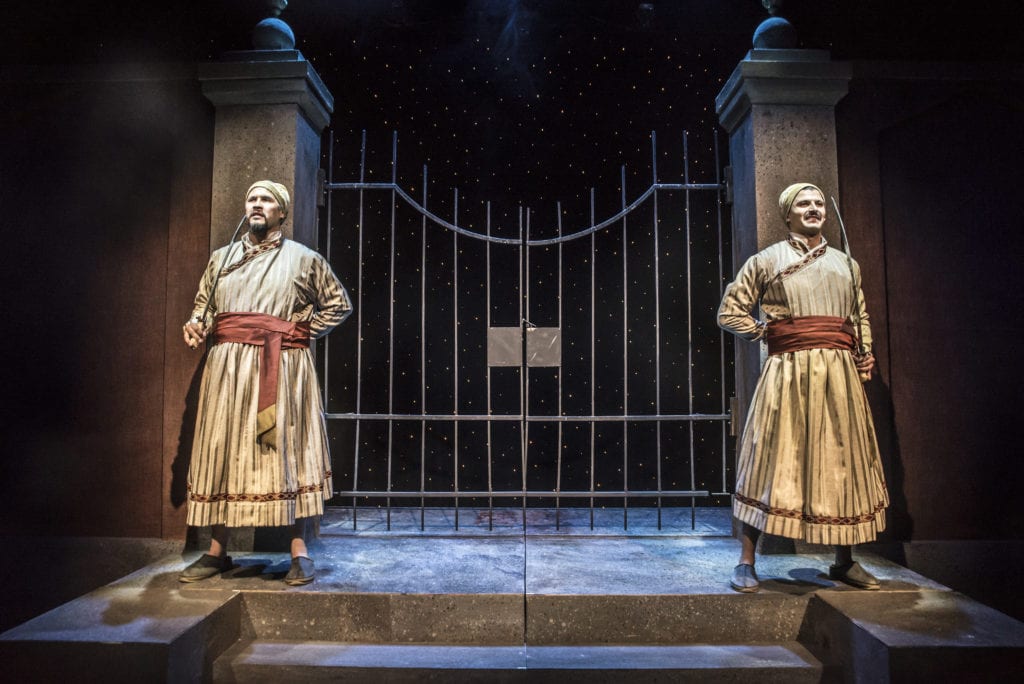
The price of beauty
‘Guards of the Taj’ elicits both horror and empathy
The second act of Guards at the Taj begins quietly, the set lights dimly casting the play’s only two characters lying, exhausted, in a pool of blood. Despite the grotesque display, this moment is placid, and questions about how the men got there are suspended. The play pauses for a moment, and the audience is left to contemplate what’s just been finished: the severing of 40,000 hands by the two dutiful guards.
The men are Barbur and Humayun, the guards in Rajiv Joseph’s 2016 play Guards at the Taj, produced by the Boulder Ensemble Theater Company. In the first act, set just a day before, we meet them as ordinary guards, stationed to stand outside the Taj Mahal, which has just been completed. Legend has it that the magnificent monument, heralded as the most beautiful building in the world at the time of its construction in 1648, was shrouded until the moment of it’s completion. Barbur and Humayun were employed to help keep it secret.
Until dawn breaks, they stand outside a wall surrounding the structure, talking to each other (although it’s forbidden) about birds and boredom and harems and silly ambitions to do more than stand watch. At day’s first light, the men turn to gaze upon the Taj Mahal for the first time. Spotlights turn to bathe them in white light. The men are as silent as the audience, which is, presumably, imagining the beauty they behold. The script works hard to paint a picture of the all-white building, made to be the perfect homage to true love.
But the play also confronts the human costs of building such a magnificent structure; in this case, a mausoleum for emperor Shah Jahan’s favorite departed wife. Legend has it that the emperor ordered the dismemberment of 20,000 workmen so that something as beautiful as the Taj could never be built again. This contrast between beauty and savagery is evident when the second act opens and the guards are bathed not in white light, but in blood.
The BETC crew, led by artistic director Stephen Weitz, build a simple world that allows actors Sam Gilstrap and Jihad Milhem to indulge the dramatic dialogue that follows, resulting in a thoroughly enjoyable (and laudable) performance. Importantly though, the simplicity of the set also allows the performance to veer into the subtleties of more absorptive acts.
Joseph’s script offers only one parenthetical cue for Act II: “(they start to mop, but realize they are just pushing around the blood).” BETC uses this as a launchpad to send the actors on a sort of dance. In its midst, the dialogue becomes secondary, extravagant.
The contrast between the horror of the blood on the floor and the sweet way the men tend to it, softly pushing the blood down a drain, hypnotizes the audience. For 30 minutes, everyone in the room is absorbed.
Yet, the dismemberment is based on folklore. Yes, it lessens the power of the bloody climax when we know the details are false, but the production still succeeds in suspending the room of its disbelief.
It helps that the dismemberment story feels like it has contemporary relevance. In this day and age, it’s difficult to imagine power or beauty could come without a horrific price. Take, for example, Trump’s casino and resort version of the Taj Mahal in Atlantic City, which not only cost investors $350 million, but contributed to the city’s ruin.
Guards at the Taj is a difficult play but one that has found a perfect home with BETC, now starting its 13th season. Artistic Director Weitz says the company is in the midst of redefining itself, looking for stories that can inspire its company and its audiences to “empathy,” and that is precisely what Guards at the Taj delivers.
